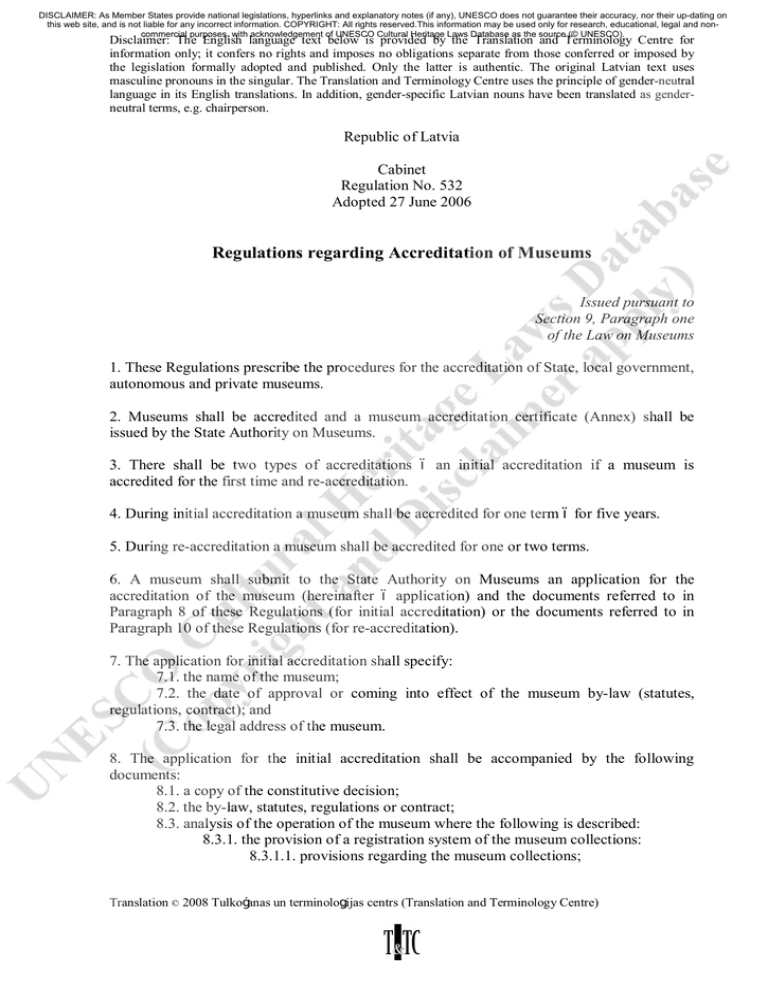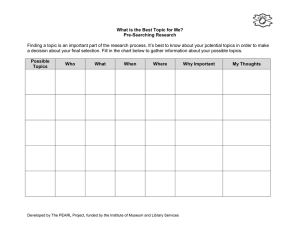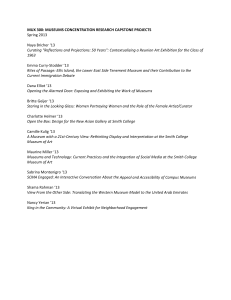
DISCLAIMER: As Member States provide national legislations, hyperlinks and explanatory notes (if any), UNESCO does not guarantee their accuracy, nor their up-dating on
this web site, and is not liable for any incorrect information. COPYRIGHT: All rights reserved.This information may be used only for research, educational, legal and noncommercial purposes, with acknowledgement of UNESCO Cultural Heritage Laws Database as the source (© UNESCO).
Disclaimer: The English language text below is provided by the Translation and Terminology Centre for
information only; it confers no rights and imposes no obligations separate from those conferred or imposed by
the legislation formally adopted and published. Only the latter is authentic. The original Latvian text uses
masculine pronouns in the singular. The Translation and Terminology Centre uses the principle of gender-neutral
language in its English translations. In addition, gender-specific Latvian nouns have been translated as genderneutral terms, e.g. chairperson.
Republic of Latvia
Cabinet
Regulation No. 532
Adopted 27 June 2006
Regulations regarding Accreditation of Museums
Issued pursuant to
Section 9, Paragraph one
of the Law on Museums
1. These Regulations prescribe the procedures for the accreditation of State, local government,
autonomous and private museums.
2. Museums shall be accredited and a museum accreditation certificate (Annex) shall be
issued by the State Authority on Museums.
3. There shall be two types of accreditations – an initial accreditation if a museum is
accredited for the first time and re-accreditation.
4. During initial accreditation a museum shall be accredited for one term – for five years.
5. During re-accreditation a museum shall be accredited for one or two terms.
6. A museum shall submit to the State Authority on Museums an application for the
accreditation of the museum (hereinafter – application) and the documents referred to in
Paragraph 8 of these Regulations (for initial accreditation) or the documents referred to in
Paragraph 10 of these Regulations (for re-accreditation).
7. The application for initial accreditation shall specify:
7.1. the name of the museum;
7.2. the date of approval or coming into effect of the museum by-law (statutes,
regulations, contract); and
7.3. the legal address of the museum.
8. The application for the initial accreditation shall be accompanied by the following
documents:
8.1. a copy of the constitutive decision;
8.2. the by-law, statutes, regulations or contract;
8.3. analysis of the operation of the museum where the following is described:
8.3.1. the provision of a registration system of the museum collections:
8.3.1.1. provisions regarding the museum collections;
Translation © 2008 Tulkošanas un terminoloģijas centrs (Translation and Terminology Centre)
DISCLAIMER: As Member States provide national legislations, hyperlinks and explanatory notes (if any), UNESCO does not guarantee their accuracy, nor their up-dating on
this web site, and is not liable for any incorrect information. COPYRIGHT: All rights reserved.This information may be used only for research, educational, legal and noncommercial purposes, with acknowledgement of UNESCO Cultural Heritage Laws Database as the source (© UNESCO).
8.3.1.2. the policy of acquisition, preservation and usage of the
collections;
8.3.2. the provision of accessibility of the museum collections:
8.3.2.1. communications policy;
8.3.2.2. policy of research work;
8.3.3. the premises, equipment and security systems guaranteeing the
preservation of the museum collections; and
8.4. the operation and development strategy of the museum for the subsequent five
years.
9. An application for re-accreditation shall specify:
9.1. the name of the museum;
9.2. the date of approval or coming into effect of the museum by-law (statutes,
regulations, contract);
9.3. the date of the initial accreditation of the museum; and
9.4. the legal address of the museum.
10. The application for re-accreditation shall be accompanied by the following documents:
10.1. the by-law, statutes, regulations or contract;
10.2. analysis of the operation of the museum where the following is described:
10.2.1. the provision of a registration system of the museum collections:
10.2.1.1. provisions regarding the museum collections;
10.2.1.2. the policy of acquisition, preservation and usage of the
collections;
10.2.2. the provision of accessibility of the museum collections:
10.2.2.1. communications policy;
10.2.2.2. policy of research work;
10.2.3. the premises, equipment and security systems guaranteeing the
preservation of the museum collections;
10.3. an operation and development strategy for the museum for a period (one or two
terms), for which the museum is applying for the receipt of accreditation; and
10.4. a report regarding the implementation of the proposals of the previous
accreditation.
11. Accreditation shall commence after the receipt of the application and documents referred
to in Paragraph 8 or 10 of these Regulations (hereinafter – submitted materials).
12. The application for accreditation shall be examined within the term specified in the
regulatory enactments regulating the administrative process.
13. If the State Authority on Museums determines that the information submitted is
insufficient, it shall send the submitter a notification requesting the necessary information.
14. If within a time period of 14 days after sending the notification referred to in Paragraph 13
of these Regulations the submitter fails to provide the State Authority on Museums with the
necessary information, the application shall not be examined and the materials submitted shall
be sent back to the submitter, accompanied by a substantiated decision regarding refusal to
accredit the museum.
Translation © 2008 Tulkošanas un terminoloģijas centrs (Translation and Terminology Centre)
2
DISCLAIMER: As Member States provide national legislations, hyperlinks and explanatory notes (if any), UNESCO does not guarantee their accuracy, nor their up-dating on
this web site, and is not liable for any incorrect information. COPYRIGHT: All rights reserved.This information may be used only for research, educational, legal and noncommercial purposes, with acknowledgement of UNESCO Cultural Heritage Laws Database as the source (© UNESCO).
15. The time period from sending the notification referred to in Paragraph 13 of these
Regulations until the receipt of the additional information shall not be included in the time
period for examination.
16. The State Authority on Museums shall examine the submitted materials, evaluate the
conformity of a museum with the museum accreditation conditions provided for in the Law
on Museums, prepare an opinion and submit these to the Latvian Council of Museums.
17. The Latvian Council of Museums shall examine the opinion prepared by the State
Authority on Museums, if necessary, assess the conformity of a museum to the museum
accreditation conditions provided for in the Law on Museums and provide an opinion
regarding the conformity of the relevant museum to the accreditation requirements.
18. In accordance with the opinion of the Latvian Council of Museums regarding the
conformity of the relevant museum to the accreditation requirements, the State Authority on
Museums shall take a decision regarding the accreditation of a museum or a substantiated
decision regarding the refusal to accredit the museum.
19. The State Authority on Museums shall publish a notification regarding accreditation of a
museum in the newspaper Latvijas Vēstnesis [the official Gazette of the Government of
Latvia].
20. The State Authority on Museums shall control the conformity of an accredited museum to
the museum accreditation conditions provided for in the Law on Museums, analyse the annual
reports of the museum and carry out inspections in the museum.
21. If the State Authority on Museums determines that the accredited museum fails to comply
with the museum accreditation conditions provided for in the Law on Museums, it shall
prepare a relevant opinion and submit it to the Latvian Council of Museums.
22. In accordance with the opinion of the Latvian Council of Museums, the State Authority on
Museums shall take a decision to withdraw the accreditation of a museum, if:
22.1. the museum is being liquidated or reorganised; or
22.2. the museum fails to comply with the museum accreditation conditions provided
for in the Law on Museums.
23. Decisions of the State Authority on Museums may be contested and appealed in
accordance with the procedures specified in the regulatory enactments regulating the
administrative process.
24. Museum accreditation certificates issued prior to the coming into force of these
Regulations remain in force until the end of the accreditation term.
Prime Minister
A. Kalvītis
Minister for Culture
H. Demakova
Translation © 2008 Tulkošanas un terminoloģijas centrs (Translation and Terminology Centre)
3
DISCLAIMER: As Member States provide national legislations, hyperlinks and explanatory notes (if any), UNESCO does not guarantee their accuracy, nor their up-dating on
this web site, and is not liable for any incorrect information. COPYRIGHT: All rights reserved.This information may be used only for research, educational, legal and noncommercial purposes, with acknowledgement of UNESCO Cultural Heritage Laws Database as the source (© UNESCO).
Annex
Cabinet Regulation No. 532
27 June 2006
Museum Accreditation Certificate No. ___
___________________________________
(place and date of issue)
Issued to ______________________________________________
(name of the museum)
______________________________________________________________
(address of the museum)
as certification for operation of State recognised museum from ________________________
(date of accreditation)
until ________________________________
(expiry date of accreditation)
Place for a seal
Head of the State Authority on Museums ____________________________
(signature and full name)
Minister for Culture
H. Demakova
Translation © 2008 Tulkošanas un terminoloģijas centrs (Translation and Terminology Centre)
4





